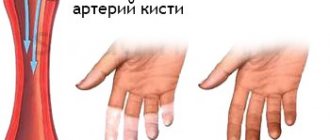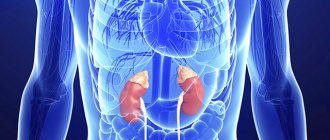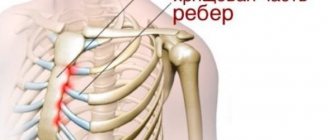The adrenal glands are glands that produce endocrine hormones that affect metabolism, create protection against stress, affect salt metabolism and many other processes. Diseases of the adrenal glands are caused by disruption of the endocrine organs, disruption of fetal development in the embryonic period, and damage to the adrenal glands. Depending on the cause of the disease, symptoms appear. Disruption of the pituitary gland can be characterized by an increase or decrease in the level of the hormone ACTH; a disruption of the feedback mechanism in the hypothalamic-pituitary-adrenal relationship occurs. Tumors of the adrenal glands lead to increased production of hormones from the glands. Malfunctions of the hormonal system, tumors, and congenital pathologies lead to the development of Itsenko-Cushing's disease, secondary adrenal insufficiency, and other disorders.
At the Yusupov Hospital, the oncology clinic diagnoses and treats tumor diseases of the adrenal glands. In the oncology clinic, diagnostics are carried out using modern equipment; the oncology department includes: an oncology hospital, a palliative hospital, and an outpatient chemotherapy department. The hospital operates using the standards and protocols of leading countries in the world. If a violation of the adrenal glands is suspected, the doctor refers the patient for research and consultation with an endocrinologist. An ultrasound is performed, an MRI or CT may be prescribed. The endocrinologist refers for hormone tests. After a complete examination and diagnosis, doctors prescribe treatment.
Symptoms, diagnosis and treatment of adrenal adenoma
Adenoma is a benign tumor that forms on the endocrine glands. The danger of this pathology lies in its ability to degenerate into a malignant form. However, even in the first form it disrupts the functioning of the glands.
Symptoms are related to the cause of the disease:
- Hormonal imbalance;
- Poor functioning of the internal secretion organs;
- As a rule, in the early stages of development there are no signs;
- As the tumor grows, the person gains weight;
- He begins to feel short of breath;
- Chest and abdominal pain;
- Excessive sweating;
- Blood pressure increases.
- The larger the tumor, the more severe the symptoms.
Adenoma in women provokes the accumulation of secondary male sexual characteristics, which do not disappear even after treatment: menstrual irregularities, the appearance of hair on the chest and face, and deepening of the voice.
How the adrenal glands affect blood pressure
The cortex of the adrenal glands produces cortisol and aldosterone, and the cells of the medulla produce adrenaline, norepinephrine and dopamine - all of these hormones predominantly increase blood pressure levels.
We recommend reading the article on how to test your adrenal glands. From it you will learn about the reasons for examination, which doctor to see, how to check the structure of the adrenal cortex and what diseases can be detected.
And here is more about the adrenal glands and excess weight.
Cortisol is the main adrenal hormone that increases blood pressure
Normally, this hormone has a regulating effect on blood circulation indicators: it dilates the vessels of the heart and brain, ensuring the flow of blood to them, improves the nutrition of muscle tissue, increases cardiac output, and speeds up the rhythm of contractions.
With excessive secretion of cortisol by the adrenal cortex, patients develop arterial hypertension - high blood pressure . At first, the systolic indicator increases mainly, and then the diastolic one.
High blood pressure numbers are recorded periodically at an early stage. Then hypertension becomes constant and tends to progress regardless of gender, age and even the concentration of cortisol itself in the blood .
This is explained by the fact that a persistent excess of the hormone:
- activates the formation of angiotensinogen in the liver (it is then converted into angiotensin 2, which causes arterial spasm);
- disrupts the ability of blood vessels to relax;
- stimulates the sympathetic nervous system;
- inhibits the synthesis of substances that expand the lumen of the arteries.
Adrenal aldosterone and blood pressure
The adrenal hormone aldosterone inhibits the excretion of sodium by the kidney tubules, while water is retained in the vascular bed, which increases blood pressure. Recent studies have proven that this is not the only mechanism of persistent hypertension under the influence of aldosterone. It also increases the flow of sympathetic impulses that spasm the arterial branches, directly constricts the blood vessels, and increases peripheral resistance.
In patients with excess aldosterone in the blood, arterial hypertension has a severe course, often leading to acute circulatory disorders in the myocardium (infarction), brain tissue (stroke), decreased vision (retinopathy), and kidney damage. When using any antihypertensive drugs, blood pressure does not decrease. Only Veroshpiron or Inspra can help.
Adrenal catecholamines and high blood pressure
Adrenaline and norepinephrine are adrenal hormones that act on adrenergic receptors in the vascular wall and heart muscle, and dopamine also acts on the corresponding dopamine receptors - the result of the complex and sometimes multidirectional actions of catecholamines is an increase in pressure and spasm of arterial vessels.
Hypertension with an excess of these hormones often has a crisis course with an increase in systolic reading to 250 or more units, with panic attacks, autonomic reactions (sweating, hand tremors), tachycardia.
Symptoms, causes and treatment of adrenal inflammation
The following pathologies can provoke the disease:
- tuberculous lesions of the gland cortex and hemorrhages in them;
- thrombosis;
- bilateral tumors (eg malignant adenoma);
- syphilitic lesions;
- amyloidosis;
- purulent inflammation;
- hereditary atrophy of their cortex;
- autoimmune disorders.
The inflammatory process is characterized by slow development. First, a person is plagued by weakness, fatigue, weight loss, and then pigmentation occurs in areas exposed to the sun or friction.
Patients have low blood pressure, poor appetite, diarrhea, vomiting, and sometimes mental disorders. It is worth noting that the severity of symptoms depends on the degree of hormonal deficiency.
Inflammation without treatment can lead to an adcison crisis, which is manifested by constant vomiting, dehydration, a drop in blood pressure, the smell of acetone from the mouth, clinical convulsions, and a state of prostration.
If necessary, anti-tuberculosis treatment is carried out, then hormonal correction is necessary. The patient's diet should contain salt, as it retains fluid in the body and increases blood pressure. As for folk methods, almost the same plants are used as for adenoma (eg snowdrop, horsetail). Calendula, licorice, black currant leaves, nettle, and knotweed herb will be useful.
Diseases leading to low blood pressure
Among the diseases of the adrenal glands that lead to a decrease in blood pressure, the most famous is Addison's disease (adrenal cortical insufficiency, primary hypocortisolism), when, for a number of reasons, the cortical layer is destroyed and adrenal hormones are produced in minimal quantities or are absent altogether.
Typical symptoms of the disease:
- increased pigmentation of the skin and mucous membranes;
- weight loss (due to gradual dehydration);
- decreased libido, asthenia;
- general weakness, increased fatigue;
- hypotension;
- digestive disorders - nausea, vomiting, constipation, diarrhea, loss of appetite, abdominal pain,
- addiction to salty foods.
The disease often occurs in the form of Addisonian crises:
- cardiovascular – cyanosis of the fingertips, nose, ears (acrocyanosis), coldness of the extremities, pale face, thready pulse, tachycardia, fainting;
- gastrointestinal - resembles a picture of acute abdomen or food poisoning (flatulence, nausea, loose stools, uncontrollable vomiting, cramping pain);
- neuropsychic – convulsions, meningeal symptoms, headache, lethargy, delirium, stupor.
Diagnostic methods
- To find out the cause of the violations, laboratory tests must be carried out. An external examination alone is not enough to make an accurate diagnosis. For example, a urine test allows you to obtain information about the concentration of hormones and their metabolites.
- A blood test provides a more detailed picture of the disorders. In the blood you can detect aldosterone, plasma renin activity, free cortisol, androgens, ACTH, and markers of CAH.
- A number of diseases require clinical examinations. Basic methods combine a set of procedures.
- First of all, they resort to ultrasound. This event allows the doctor to assess the structure of the glands, their location, identify pathologies and dysfunctions, and assess the blood supply to the adrenal glands.
- In the absence of the necessary information, tomography and radiography are prescribed. Ancillary diagnostic methods include MRI and CT. They allow us to determine the level and prevalence of complications that arise in the absence of treatment.
- If an adenoma is suspected, an ultrasound, a detailed blood test with determination of the concentration of specific hormones, CT scan, biopsy and brain tomography are performed. Ultrasound and MRI make it possible to determine the size of the tumor, its structure, location, and area of tissue damage. Tomography is performed to exclude pituitary adenoma.
The diagnosis of “inflammation of the adrenal glands” is confirmed using ultrasound, blood tests, urine tests, when the primary focus of tuberculosis is identified.
Diseases of the adrenal glands with increased, high blood pressure
Excessive release of adrenal hormones in connection with diseases leads to symptomatic arterial hypertension, they are presented in the table.
| Name of the disease | Manifestations |
| Itsenko-Cushing's syndrome and disease | Excess cortisol appears with a tumor (adenoma) of the pituitary gland, adrenal glands (corticosteroma, glucosteroma, adenocarcinoma), when using Hydrocortisone, Prednisolone or their analogues for treatment. Accompanied by obesity, diabetes, osteoporosis, and sexual dysfunction. |
| Hyperaldosteronism | It happens with nodular growth of the cortex or the appearance of a tumor that produces aldosterone. In addition to hypertension, patients experience progressive muscle weakness, arrhythmia, decreased vision, seizures, and numbness of the extremities. |
| Pheochromocytoma | Hormonally active tumor of the medulla, predominantly of hereditary origin. Most often it occurs with crises; they can be provoked by stress, overheating, physical activity, alcohol intake, and certain medications. |
What is known about these organs?
The structural structure of the adrenal glands is represented by glandular tissue. Their stroma has two functional parts – the outer (cortical) and the inner (cerebral). The cells of these zones produce completely different hormones. These active substances are formed mainly during the breakdown of cholesterol molecules.
The adrenal glands are located in the lumbar region of the back. According to the name of the glands, they are located in the upper part of the kidneys, that is, “above” them. These organs can be visually examined during ultrasound diagnostics. These structures resemble small discs in appearance, with the right gland having a pyramidal shape, and the left gland being more crescent-shaped in outline.
What are these glandular organs responsible for? The main function of the adrenal glands is the synthesis of hormonal substances that regulate the functioning of other structural parts of the body. The glands produce about 30 different hormones, so failure of their performance always causes deterioration of the condition not only in women, but also in men.
Examples of the main active substances they produce will help you consider the functions of the adrenal glands in more detail. Organs produce the following hormones:
- Glucocorticoids are responsible for the metabolism of simple and complex carbohydrates, reduce the activity of the inflammatory process. Produced by the cortical zone.
- Norepinephrine and adrenaline are the result of the work of the medulla of the glands; these substances take part in the functioning of the nervous system (transmit impulses along nerve fibers).
- Mineralocorticoids - their duty is to regulate the water-lipid balance in the body.
- Sexual - ensure the proper functioning of the reproductive system, have a direct impact on the process of conceiving future offspring and the manifestation of secondary sexual characteristics in women (men).
Features and classification of adrenal pathologies
Impaired functioning of these structures manifests itself in the form of too strong secretion of hormonal substances or their insufficiency. Therefore, diseases of these organs in medicine are systematized as follows:
- Diseases caused by limited production of active substances - this category includes the acute type of glandular deficiency, its secondary and primary form (Addison's disease).
- Diseases caused by excessive secretion of hormones - Conn and Itsenko-Cushing syndrome, adrenal cortical hyperplasia, pheochromocytoma.
If the glands do not work correctly, quite severe disorders appear throughout the body. The regulation of all physiological processes changes and organs can no longer function normally. Below, the symptoms of adrenal disease in women are described in more detail.
Structure
There are two parts that make up this organ.
- The first is the bark. It makes up 90% of the entire gland. It is also divided into three parts - outer, middle and inner. It must be said that they all produce completely different hormones.
- The second is the brain matter, which occupies the remaining 10%.
The adrenal glands produce hormones that are necessary for normal human life. And if any disease of this organ suddenly occurs, then a disruption of vital functions occurs.
Hypercortisolism
This condition includes Itsenko-Cushing's disease, a severe disorder of neuroendocrine regulation, leading to bilateral enlargement of the adrenal cortex. Overproduction of corticosteroids (cortisol) by the adrenal glands is the cause of endocrine hypertension.
Cortisol ensures a person’s adaptation to stress factors; its production by the adrenal glands is stimulated by another hormonal organ - the pituitary gland through adrenocorticotropic hormone (ACTH).
The production of this hormone increases against the background of a microadenoma (benign tumor) in the pituitary gland. ACTH constantly forces the adrenal cortex to work, as a result of which it hypertrophies.
Hypercortism may be a consequence of Itsenko-Cushing syndrome, which develops as a result of long-term use of glucocorticoid hormones or the occurrence of a tumor in the adrenal cortex.
Arterial hypertension in this pathology is moderate, but its prolonged existence leads to vascular disorders.
- Disproportionate obesity;
- Arterial hypertension;
- Muscular atrophy of the limbs;
- Moon-shaped face;
- Purple stretch marks on the body;
- Osteoporosis;
- Mental disorders;
- Thirst;
- Increased blood glucose levels;
- Heart failure;
- Excessive hair growth.
Hypercortisolism is supported by increased levels of cortisol and ACTH in the blood, 17-OX and free cortisol in the urine per day, and a high dexamethasone test.
Treatment
Endocrine hypertension with hypercortisolism can be treated with conventional therapy, but without tumor removal, the severity of the patient’s condition increases. When a clear localization of the pituitary microadenoma is determined, a neurosurgical operation is performed in a specialized hospital. Recovery occurs in 80% of cases, but relapse may occur.
Replacement therapy is carried out for a short time. If it is not possible to determine the tumor, proton therapy is recommended for the pituitary gland and simultaneous removal of one adrenal gland. Neoplasms (adrenales) are removed surgically and short-term replacement therapy is carried out.
The main drug treatment for Cushing's disease is the prescription of drugs that suppress the production of ACTH and blockers of corticosteroid production. Against this background, it is additionally recommended:
- Vitamins, potassium preparations;
- Antihypertensives – ACE inhibitors;
- Spironolactone;
- Osteoporosis is treated.
In severe cases of the disease, both adrenal glands are removed, followed by lifelong replacement therapy with glucomineralocorticoids. All patients require long-term observation by an endocrinologist, therapist, or neurologist.











